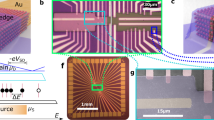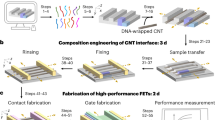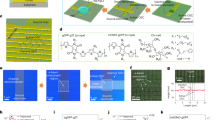Abstract
Self-assembly—the autonomous organization of components into patterns and structures1—is a promising technology for the mass production of organic electronics. Making integrated circuits using a bottom-up approach involving self-assembling molecules was proposed2 in the 1970s. The basic building block of such an integrated circuit is the self-assembled-monolayer field-effect transistor (SAMFET), where the semiconductor is a monolayer spontaneously formed on the gate dielectric. In the SAMFETs fabricated so far, current modulation has only been observed in submicrometre channels3,4,5, the lack of efficient charge transport in longer channels being due to defects and the limited intermolecular π–π coupling between the molecules in the self-assembled monolayers. Low field-effect carrier mobility, low yield and poor reproducibility have prohibited the realization of bottom-up integrated circuits. Here we demonstrate SAMFETs with long-range intermolecular π–π coupling in the monolayer. We achieve dense packing by using liquid-crystalline molecules consisting of a π-conjugated mesogenic core separated by a long aliphatic chain from a monofunctionalized anchor group. The resulting SAMFETs exhibit a bulk-like carrier mobility, large current modulation and high reproducibility. As a first step towards functional circuits, we combine the SAMFETs into logic gates as inverters; the small parameter spread then allows us to combine the inverters into ring oscillators. We demonstrate real logic functionality by constructing a 15-bit code generator in which hundreds of SAMFETs are addressed simultaneously. Bridging the gap between discrete monolayer transistors and functional self-assembled integrated circuits puts bottom-up electronics in a new perspective.
This is a preview of subscription content, access via your institution
Access options
Subscribe to this journal
Receive 51 print issues and online access
$199.00 per year
only $3.90 per issue
Buy this article
- Purchase on Springer Link
- Instant access to full article PDF
Prices may be subject to local taxes which are calculated during checkout




Similar content being viewed by others
References
Whitesides, G. M. & Grzybowski, B. Self-assembly at all scales. Science 295, 2418–2421 (2002)
Aviram, A. & Ratner, M. A. Molecular rectifiers. Chem. Phys. Lett. 29, 277–283 (1974)
Guo, X. et al. Chemoresponsive monolayer transistors. Proc. Natl Acad. Sci. USA 103, 11452–11456 (2006)
Tulevski, G. S. et al. Attaching organic semiconductors to gate oxides: in situ assembly of monolayer field effect transistors. J. Am. Chem. Soc. 126, 15048–15050 (2004)
Mottaghi, M. et al. Low-operating-voltage organic transistors made of bifunctional self-assembled monolayers. Adv. Funct. Mater. 17, 597–604 (2007)
Onclin, S., Ravoo, B. J. & Reinhoudt, D. N. Engineering silicon oxide surfaces using self-assembled monolayers. Angew. Chem. Int. Edn 44, 6282–6304 (2005)
Garnier, F. et al. Molecular engineering of organic semiconductors: design of self-assembly properties in conjugated thiophene oligomers. J. Am. Chem. Soc. 115, 8716–8721 (1993)
Halik, M. et al. relationship between molecular structure and electrical performance of oligothiophene organic thin film transistors. Adv. Mater. 15, 917–922 (2003)
van Breemen, A. J. J. M. et al. Large area liquid crystal monodomain field-effect transistors. J. Am. Chem. Soc. 128, 2336–2345 (2006)
Ponomarenko, S. A. et al. Star-shaped oligothiophenes for solution-processible organic electronics: flexible aliphatic spacers approach. Chem. Mater. 18, 4101–4108 (2006)
McCulloch, I. et al. Liquid-crystalline semiconducting polymers with high charge-carrier mobility. Nature Mater. 5, 328–333 (2006)
Yoneda, Y. Anomalous surface reflection of X rays. Phys. Rev. 131, 2010–2013 (1963)
Fenter, P. in Self-Assembled Monolayers of Thiols (ed. Uhlman, A.) 111–147 (Academic, 1991)
Fichou, D. Handbook of Oligo- and Polythiophenes (Wiley-VCH, 1999)
Melucci, M. et al. Multiscale self-organization of the organic semiconductor α-quinquethiophene. J. Am. Chem. Soc. 125, 10266–10274 (2003)
Dinelli, F. et al. Spatially correlated charge transport in organic thin film transistors. Phys. Rev. Lett. 92, 116802 (2004)
Ruiz, R., Papadimitratos, A., Mayer, A. C. & Malliaras, G. G. Thickness dependence of mobility in pentacene thin-film transistors. Adv. Mater. 17, 1795–1798 (2005)
Park, B.-N. Seo, S. & Evans, P. G. Channel formation in single-monolayer pentacene thin film transistors. J. Phys. D 40, 3506–3511 (2007)
Cantatore, E. & Meijer, E. J. in ESSCIRC ’03 29–36 (Proc. 29th Eur. Solid State Circuits Conf., IEEE, 2003)
Cantatore, E. et al. A 13.56-MHz RFID system based on organic transponders. IEEE J. Solid State Circuits. 42, 84–92 (2007)
Acknowledgements
We acknowledge H. Nulens and C. van der Marel for the AFM and X-ray photoemission spectroscopy measurements, M. Kaiser for the FIB-TEM analysis, A. P. Pleshkova for the mass spectrometry analysis, F. Zontone for technical assistance and N. Willard for discussions. We acknowledge financial support from the Dutch Polymer Institute, project 516, the EU project NAIMO (NMP4-CT-2004-500355), the Dutch Technology Foundation STW, the Austrian Science Foundation and H. C. Starck GmbH. We thank the European Synchrotron Research Facility for the use of the beamline ID10B.
Author information
Authors and Affiliations
Corresponding authors
Supplementary information
Supplementary Information
This file contains Supplementary Information with Supplementary Figures S1-S31, Supplementary Tables S1-S4 and Supplementary References. (PDF 1273 kb)
Rights and permissions
About this article
Cite this article
Smits, E., Mathijssen, S., van Hal, P. et al. Bottom-up organic integrated circuits. Nature 455, 956–959 (2008). https://doi.org/10.1038/nature07320
Received:
Accepted:
Issue Date:
DOI: https://doi.org/10.1038/nature07320
This article is cited by
-
Formation of hierarchically ordered structures in conductive polymers to enhance the performances of lithium-ion batteries
Nature Energy (2023)
-
Functionalising the gate dielectric of organic field-effect transistors with self-assembled monolayers: effect of molecular electronic structure on device performance
Applied Physics A (2022)
-
Approaching isotropic charge transport of n-type organic semiconductors with bulky substituents
Communications Chemistry (2021)
-
Effectively modulating thermal activated charge transport in organic semiconductors by precise potential barrier engineering
Nature Communications (2021)
-
Dual-function surfactant strategy for two-dimensional organic semiconductor crystals towards high-performance organic field-effect transistors
Science China Chemistry (2021)
Comments
By submitting a comment you agree to abide by our Terms and Community Guidelines. If you find something abusive or that does not comply with our terms or guidelines please flag it as inappropriate.



